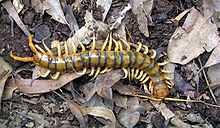Ethmostigmus rubripes
| Ethmostigmus rubripes | |
|---|---|
 | |
| Scientific classification | |
| Kingdom: | Animalia |
| Phylum: | Arthropoda |
| Subphylum: | Myriapoda |
| Class: | Chilopoda |
| Order: | Scolopendromorpha |
| Family: | Scolopendridae |
| Genus: | Ethmostigmus |
| Species: | E. rubripes |
| Binomial name | |
| Ethmostigmus rubripes (Brandt, 1840) | |
Ethmostigmus rubripes, the giant centipede, is the largest Australasian and Asian centipede. Head and body length 7.5 to over 16 cm (6¼ inches). The body is long and flattened. Coloration is dark or greenish-brown to orange or orange-yellow with black bands, with yellow legs and antennae; southern specimens tend to have blue or dark antennae. Ethmostigmus rubripes also have various subspecies which may explain the many colour forms of this species.
Habitat and range
It is found in both dry and moist habitats, usually in sheltered places such as under logs, leaf litter and bark, and under rocks. It is solitary, terrestrial and a nocturnal predator. It is common throughout Australia, the Solomon Islands, New Guinea, Indonesia, Southeast Asia and China.
The giant centipede has modified claws called forcipules which curve around its head and can deliver venom into its prey. The venom is toxic to both mammals and insects, but does not appear to be strong enough to kill large animals quickly. It can cause severe pain in humans which can last for several days but which can be relieved somewhat by the application of icepacks. Some people report "intense pain", while others claim it is no worse than a wasp sting. There has been at least one reported death from the related centipede species Scolopendra subspinipes in which a young girl was bitten and died.[1]

References
- ↑ Robert L. Norris (November 19, 2008). "Centipede Envenomation". eMedicine. Retrieved October 29, 2010.
- Wildlife of Tropical North Queensland. 2000. Queensland Museum. ISBN 0-7242-9349-3
- Ménez, André et al. "Venom apparatus and toxicity of the centipede Ethmostigmus rubripes (Chilopoda, Scolopendridae)." Journal of Morphology. 2005. Vol. 206, Issue 3, pp. 303-312.
- Cooktown Local News, Issue 307, March 28, 2007, pp. 1 and 11.
- "Is this the nation's biggest centipede?" The Cairns Post. March 30, 2007, pp. 1 and 3.
External links
- Australian Museum online
- Australian Faunal Directory
 Data related to Ethmostigmus rubripes at Wikispecies
Data related to Ethmostigmus rubripes at Wikispecies